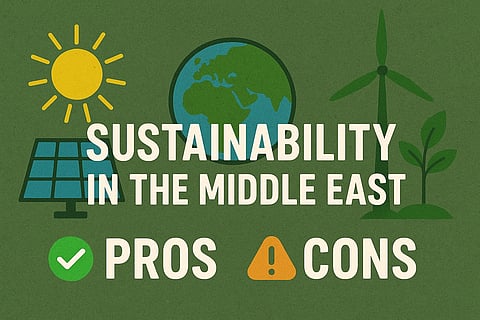Sustainability in the Middle East: Balancing Ambition and Reality
The Middle East stands at a critical juncture. Once known primarily for its vast oil reserves, the region is now striving to redefine itself as a global leader in sustainability and clean energy. From the gleaming solar farms of the UAE to Saudi Arabia’s futuristic city of NEOM, ambitious projects promise a greener future.
Yet, beneath the surface lies a complex balance between economic ambition, environmental necessity, and political reality.
The Promise of Sustainability: Key Advantages
Abundant Renewable Energy Potential
The Middle East enjoys some of the world’s most favorable conditions for solar energy production. The Arabian Peninsula receives over 3,000 hours of sunlight per year, offering immense potential for large-scale solar farms.
The Mohammed bin Rashid Al Maktoum Solar Park in Dubai aims for 5,000 MW capacity by 2030.
Saudi Arabia’s Sakaka Solar Project and Egypt’s Benban Solar Park are transforming energy landscapes.
The region’s geography also supports wind energy—notably in Egypt’s Gulf of Suez and Oman’s coastal areas—diversifying renewable options beyond solar.
Strong Government Vision and Policy Drive
Sustainability is no longer an afterthought; it’s embedded into national strategies:
UAE Net Zero 2050
Saudi Vision 2030
Qatar National Vision 2030
Egypt Vision 2030
These frameworks emphasize renewable energy, sustainable urban planning, and circular economies. For instance, Masdar City in Abu Dhabi and NEOM in Saudi Arabia showcase futuristic models of carbon-neutral living and smart city design.
Economic Diversification and Job Creation
As oil demand faces long-term uncertainty, sustainability provides a lifeline for economic diversification. Green industries — from hydrogen production and carbon capture to eco-tourism and green finance — are creating thousands of jobs while reducing reliance on hydrocarbons.
The rise of green tech start-ups and sustainability-linked bonds signals a shift toward an innovation-driven economy.
Technological Leadership
The region is embracing advanced technologies to address its unique climate and resource challenges. The UAE’s Barakah Nuclear Plant supports clean energy goals, while ADNOC’s carbon capture projects aim to store millions of tonnes of CO₂ annually.
Meanwhile, research into AI-driven desalination, waste-to-energy, and green hydrogen positions the Middle East as a testbed for sustainable innovation.
Global Climate Diplomacy
By hosting COP28 in Dubai, the UAE elevated the Middle East’s voice in global climate negotiations. The event underscored the region’s potential to serve as a bridge between developed and developing nations, fostering inclusive dialogue and investment in green transitions.
The Challenges: Complex Realities Behind the Ambition
Persistent Fossil Fuel Dependence
Despite the rhetoric of transition, oil and gas still dominate the region’s GDP and exports. State revenues and employment remain tied to hydrocarbons, creating economic inertia. While countries invest in renewables, fossil fuels continue to fund much of the green agenda — an irony not lost on global observers.
High Energy Consumption and Emissions
Per capita CO₂ emissions in Gulf countries are among the world’s highest, driven by energy-intensive lifestyles, heavy cooling demand, and industrial output. Transitioning to low-carbon living requires behavioral shifts, regulatory enforcement, and energy efficiency upgrades across sectors.
Water Scarcity and Desalination Dependence
Water scarcity remains one of the Middle East’s gravest environmental challenges. Most nations rely heavily on desalination — a process that is energy-intensive and environmentally taxing. Without sustainable desalination technologies, water security could undermine other sustainability efforts.
Implementation Gaps
Many sustainability projects are launched with fanfare but face slow implementation, lack of transparency, or limited measurable impact. Critics argue that “greenwashing” occasionally overshadows genuine progress, as headline-grabbing announcements outpace on-ground delivery.
Unequal Access and Social Impact
While the sustainability drive generates new opportunities, benefits are not always evenly shared. Migrant laborers and low-income communities often remain excluded from green job opportunities or affordable housing within sustainable developments. Social inclusion remains a missing link in the region’s green narrative.
Political and Regional Instability
Ongoing conflicts and geopolitical rivalries in parts of the Middle East complicate cross-border collaboration on renewable energy grids, water-sharing agreements, and environmental treaties. Stability remains a prerequisite for long-term sustainability planning.
The Road Ahead: From Vision to Transformation
The Middle East’s sustainability journey is a story of bold ambition meeting complex reality. The region has the wealth, sunlight, and willpower to lead a global green revolution. Yet success depends on genuine structural transformation — reducing fossil dependence, fostering transparency, engaging communities, and investing in innovation that benefits all.
If governments and industries can align profit with planet, the Middle East could evolve from being an energy exporter to a sustainability exporter — setting new standards for resilience in an era of climate change.
In short: The Middle East’s sustainability story is neither purely optimistic nor pessimistic — it’s transitional. The seeds of a green future are planted, but nurturing them will demand courage, cooperation, and consistency.


